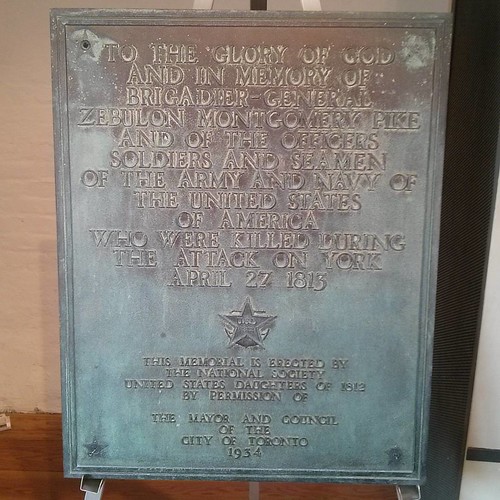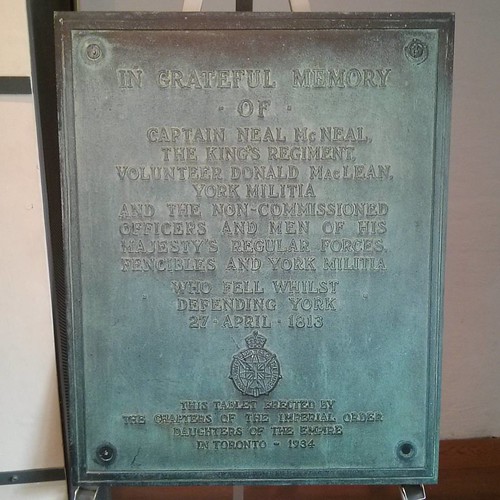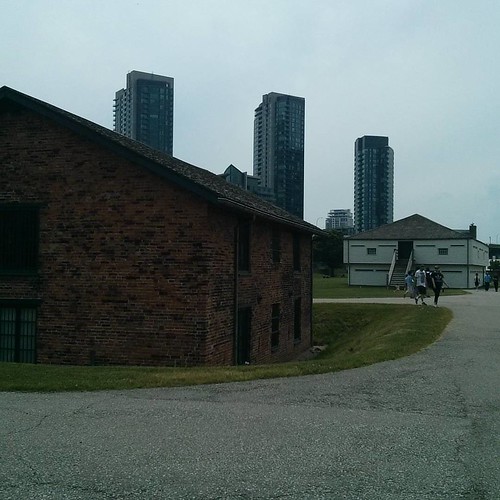Archive for May 2016
[AH] On different Anglo-American relationships in the 19th century
This morning’s photo post about Fort York, and tangentially the War of 1812 and the wider theme of Anglo-American relations, made me think about the different ways relations between the United States and the British Empire have been depicted in alternative history.
Sometimes scenarios are imagined in which the Thirteen Colonies never break away from the Empire, producing a range of results as variable as these colonies becoming the powerhouses of a superpower tranatlantic commonwealth to North America becoming a restive continent-sized Ireland. Other times, scenarios are imagined where the British Empire and the United States end up becoming committed enemies, the established power and the rising one fighting over borders and spheres of influence, with or without allies. I think it might be relatively rare that the two polities are shown as having a peaceful relationship from the start. Perhaps it’s because peace isn’t as interesting?
What I find fascinating about the War of 1812 is that it represents a point at which Anglo-American relations could have tipped into one pattern or the other. Had there been more adroit diplomats in both countries, the war could have been avoided altogether, and Anglo-American relations would have been much warmer earlier. Had one side or both pushed more, we could have had different boundaries. Had the war started earlier and lasted longer, been more a North American theatre of the Napoleonic Wars, the long-term consequences would be incalculable. The Toronto I live in and love certainly wouldn’t be the same city, whether under American jurisdiction or alternatively as part of a polity extending even deeper into the Midwest or as something else entirely. Relatively minor changes could have ballooned into huge things.
(I suppose this, this demonstration of the butterfly effect writ large, is why I like alternate history so much. Small things matter, have import. What greater reassurance can anyone have than this?)
[WRITING] On queer content and fan fiction and representation generally
The title for Rae Binstock’s lkatest entry at Slate‘s Outward, “Why Do Queer People Write Fan Fiction? To See Themselves in Mainstream Culture.”, is admittedly clickbaity. The content, which examines why people write so much slash fan fiction, deserves something subtler. The desire for better queer representation remains an ongoing issue that these fan fiction writers try to fill.
One writer of slash fan fiction, who wished to remain anonymous—professing, like many I interviewed for this article, to being “ashamed” of her involvement with the fan fiction community—pointed to the double standard between onscreen romances for straight and queer couples. “The sort of love stories I like are totally reflected and visible in [mainstream media’s] canon straight romances,” she said. “Professionally produced media doesn’t give me that sort of well-written, emotionally devastating love story with LGBT+ characters.” The eroticism, the passion, the high stakes—in most cases, these are all reserved for straight characters. It’s up to the queer fans to claim them for themselves.
Take, for instance, the Marvel Cinematic Universe, where the superpowered members of the Avengers are mostly male, toned as hell, and love to banter: Right out of the gate, fans were eagerly exploring the possibilities of Tony Stark, aka Iron Man, and Steve Rogers, aka Captain America, becoming lovers. On Ao3, there are almost 10,000 stories pairing the two romantically; that’s 3,000 more than the next most popular pairing, which also features two male characters in a queer relationship (Agent Coulson and Hawkeye). Parks and Recreation, one of television’s most beloved sitcoms, has more stories that romantically pair protagonist Leslie Knope with her female best friend, Ann Perkins, than with her husband, Ben Wyatt. And in case you were wondering, Shakespeare fan fiction does exist, and yes, Henry IV’s Prince Hal does fall in love with his childhood friend Ned.
This re-pairing of characters can be written off as unsatisfied fans indulging in wish fulfillment and the occasional erotic daydream. Outsiders who have ventured into the world of fan fiction—including Slate’s David Plotz and Laura Miller—have struggled to remain neutral while describing the genre, referring to an “obsession with emotional intensity” that has “spawned slash” or raising eyebrows at “romances, often torrid, between ostensibly straight male characters.” But when you are a member of the product’s original target audience—when you identify with characters whose sexualities are socially approved and unthreatening—you are much less likely to understand how empowered one can feel when writing queer romance into straight stories. There is power in giving Harry Potter a crush on Draco Malfoy, or creating a world in which Scandal’s Olivia and Mellie leave Fitz for each other; there is power in creating a means by which those in the mainstream might see from your sidelined point of view. It’s easy to trivialize, but the fact is that fan fiction is one of the few outlets that an increasingly frustrated queer audience has to engage with material that refuses to engage with them.
There’s a few things I’d like to engage with here. The first is whether or not queer authors have a responsibility to represent queer realities in whatever form they can. Another is the extent to which this representation has to be plausible and artistically compelling: In Deep Space Nine, for instance, I find an O’Brien/Bashir pairing much less plausible and interesting than a Garak/Bashir pairing. As well, is this something that will change over time, as things continue to improve? Will more explicit queer content, and characters, and representation lead to a decline of slash?
[URBAN NOTE] “How Toronto Can Expand Bike Parking”
Torontoist’s Emily Macrae looks at how Toronto can learn from Strasbourg’s approach to bikes, to bike parking in particular.
Cycling is a big deal in France’s seventh largest city. Strasbourg boasts 560 kilometres of bike lanes and 19,000 bike parking posts for a population of just over 275,000 in the city itself and around 768,000 in the metropolitan area. By comparison, Toronto has slightly more than 400 kilometres of bike lanes (including both protected cycle tracks and off-road trails) and 17,000 “post and ring” parking stands on sidewalks and boulevards.
One of these is not like the other.
The success of cycling infrastructure in Strasbourg is a result of partnerships between the city and other transportation agencies. Parcus, the city’s arms-length parking authority, manages parking lots throughout Strasbourg and incorporates bike parking as part of its facilities. Parcus provides free, supervised bike parking at five different parking lots across the city. Parking attendants are even equipped with repair kits and bike pumps.
In Toronto, the City’s Transportation Services Division is responsible for sidewalk bike parking as well as other short- and long-term bike parking facilities. Although Toronto is not yet home to automated underground bike storage, Transportation Services manages several other solutions that allow for a higher volume of bike parking and a greater level of security.
Much more there.
[URBAN NOTE] “Bike-lane violators easy to find on ride-along”
The Toronto Star‘s Ben Spurr writes about the Toronto police’s apparently continued pursuit of bike-lane violators.
Cyclists aren’t shy about giving David Armstrong advice on how to do his job.
“Give him the ticket, man!” shouted one rider on Monday afternoon, as Armstrong, a shift supervisor for Toronto Parking Enforcement, wrote up a driver for parking in a bicycle lane. “This is bulls–t!” the cyclist added before he pedalled away.
Monday marked first day of “Right 2 Bike,” a weeklong enforcement blitz targeting illegal parking in bicycle lanes.
To the many frustrated cyclists who complain about being forced into traffic by inconsiderate motorists, the blitz, which coincided with the annual Bike to Work Day, was long overdue.
But despite photos frequently circulated on social media that show cars invading Torontos’ bike lanes with seeming impunity, Armstrong is adamant that the parking enforcement unit takes the issue very seriously. According to the police, officers have issued over 23,000 tickets to drivers parked in bike lanes or separated cycle tracks since 2013.
[URBAN NOTE] “TTC letter warns homeowners their houses might be expropriated for Scarborough subway”
San Grewal’s Toronto Star article isn’t surprising. Scarborough may well want a subway to symbolize its inclusion in a greater Toronto, but there will be costs. The expropriation of property is just the start: the transformation of entire neighbourhoods is in the offing.
Residents on a quiet Scarborough street, some who have lived there for four decades, have received letters from the TTC warning them their houses might be expropriated to make room for the new subway extension.
“I’m not going, they’re going to kill me to take me out of here,” Scott Cole said Monday, after receiving a letter on May 25 from the “Toronto Transit Commission” informing him that the bungalow he’s lived in on Stanwell Dr. for 26 years might be subject to a “Property Acquisition Process.”
There has been no official approval of the subway alignment — running north-south under McCowan Rd., which the homes back onto — that would affect these homeowners, but they’re now convinced it’s a done deal.
The letter says this particular alignment will be presented at a public meeting Tuesday, the first in a series of meetings planned over the next three weeks. However, the letter, received by at least a dozen neighbours, says no decision has yet been made by council, and the recommendation has not even been seen by the City of Toronto’s executive committee.
[URBAN NOTE] On the continued detention of Toronto 18 leader Fahim Ahmad
The National Post‘s Stewart Bell reports on the decision to deny the leader of the Toronto 18 release. This isn’t something I necessarily have a problem with given the scale of what the group planned, which included multiple truck bombs in Toronto and the planned decapitation of the prime minister in Ottawa. The lack of effective rehabilitation programs is a concern, as I mentioned yesterday.
A decade after his arrest, the leader of the Toronto 18 terrorist group has made “insufficient change” to warrant release from prison, the Parole Board of Canada has ruled.
Following a hearing, the Board said in a seven-page decision that while Fahim Ahmad had recently “entered a process of change,” he still did not appreciate the seriousness of his crimes.
The 31-year-old, who organized training camps to prepare recruits for attacks in Ontario, has “no viable release plan” and continues to exhibit concerning behaviors, the Board wrote.
[. . .]
Ahmad, a Canadian born in Afghanistan, pleaded guilty to terrorism offences in 2010. He was scheduled for statutory release in August 2015 but the Board decided he wasn’t ready.
[PHOTO] Eleven photos from Fort York, Toronto on Doors Open
My first stop at Doors Open was Fort York, a National Historic Site. The geography around Fort York has changed hugely: Once an outpost on the western fringes of Toronto, on the shore of Lake Ontario by the mouth of Garrison Creek, the fort is now at least two hundred metres inland. Even when I first moved to Toronto in 2004, it seemed as if all there was down here were vast fields of mud. Now, the old fort is surrounded by condo towers.
After taking the 63 Ossington southbound to Strachan Avenue, I ended up entering Fort York from that street, on its western edge. I spent the next few minutes walking through parkland, until I came to the Fort proper.
The stone-lined ramparts are inauthentic, product of the fort’s reconstruction in the 1930s.
The officers’ quarters, on the northwestern corner of the fort, spoke of the relative comfort and style enjoyed by the commanders at the base. (The common soldiers enjoyed rather less.)
Looking east towards the other buildings on the fort, Toronto’s skyline–specifically, the CN Tower and the condo towers of Harbourfront–stands out.
This cannon is facing what is now the rail line, perhaps defending against oncoming GO trains.
In 1934, American and Canadian/Commonwealth groups put up plaques in memory of the dead of the Battle of York, now on display to visitors inside.
The Brick Magazine lies at the far eastern end of the Fort complex.
Looking west from Bathurst Street, Fort York barely appears visible from behind the ramparts.










